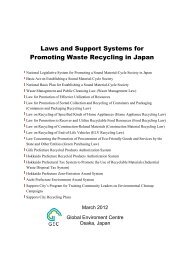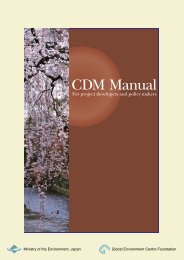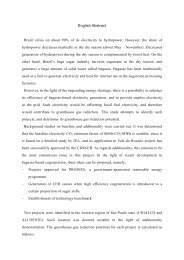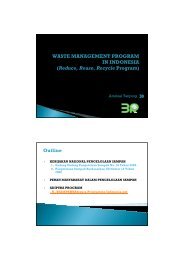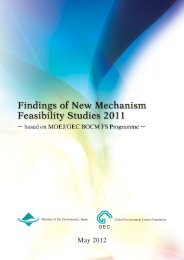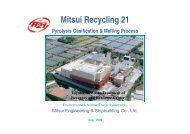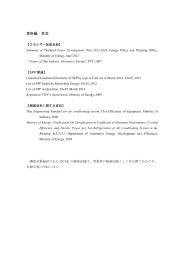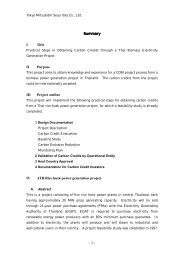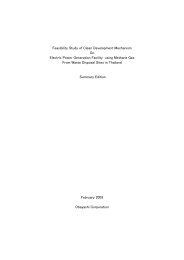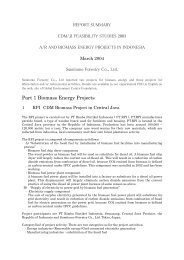PDF File - GEC
PDF File - GEC
PDF File - GEC
Create successful ePaper yourself
Turn your PDF publications into a flip-book with our unique Google optimized e-Paper software.
carbon pools within the project boundary, but project participants may choose not to account<br />
for one or more carbon pools if they provide transparent and verifiable information showing<br />
that the choice will not increase the expected net GHG removals. The general characteristics of<br />
a baseline are contained in paragraphs 20 to 22 of the CDM A/R M&P.<br />
Establishment of Baseline net GHG removals<br />
The baseline GHG removals for a proposed A/R CDM project shall be established:<br />
• By project participants in accordance with provisions for the use of approved and new<br />
baseline methodologies (contained in decision 19/CP.9, the CDM A/R M&P and relevant<br />
decisions of the COP/MOP);<br />
• In a transparent and conservative manner regarding the choice of approaches, assumptions,<br />
methodologies, parameters, data sources, key factors and additionality, and taking into<br />
account uncertainty;<br />
• On a project-specific basis;<br />
• In the case of small scale A/R CDM project activities, in accordance with simplified<br />
modalities and procedures developed for such activities;<br />
• Taking into account relevant national and/or sectoral policies and circumstances, such as<br />
historical land uses, practices and economic trends.<br />
Carbon pools and baseline net GHG removals<br />
In calculating the baseline GHG removals and/or actual GHG removals, project participants<br />
may choose not to account for one or more carbon pools, and/or emissions of the GHGs<br />
measured in CO 2 equivalents, while avoiding double counting. This is subject to the provision<br />
of transparent and verifiable information that the choice will not increase the expected GHG<br />
removals. Project participants shall otherwise account for all significant changes in carbon<br />
pools and/or emissions of the GHGs measured in CO 2 equivalents by the sources that are<br />
increased as a result of the implementation of the A/R project activity, while avoiding double<br />
counting.<br />
Baseline approaches<br />
In choosing a baseline methodology for an A/R CDM project activity, project participants<br />
shall select from among the following approaches the one deemed most appropriate for the<br />
project activity, taking into account any guidance by the EB, and justify the appropriateness of<br />
their choice:<br />
• Existing or historical, as applicable, changes in carbon stocks in the carbon pools within the<br />
project boundary;<br />
• Changes in carbon stocks in the carbon pools within the project boundary from a land use<br />
that represents an economically attractive course of action, taking into account barriers to<br />
investment;<br />
• Changes in carbon stocks in the pools within the project boundary from the most likely<br />
land use at the time the project starts.<br />
Section C.6. Assessment and demonstration of additionality<br />
The concept of additionality in A/R CDM project activities is basically the same as that of the emission<br />
reduction CDM. The concept of additionality in A/R CDM is defined in A/R CDM M&P as follows:<br />
“The proposed A/R CDM project activity is additional if the actual net GHG removals by sinks are<br />
increased above the sum of the changes in carbon stocks in the carbon pools within the project<br />
boundary that would have occurred in the absence of the registered A/R CDM project activities.”<br />
59




